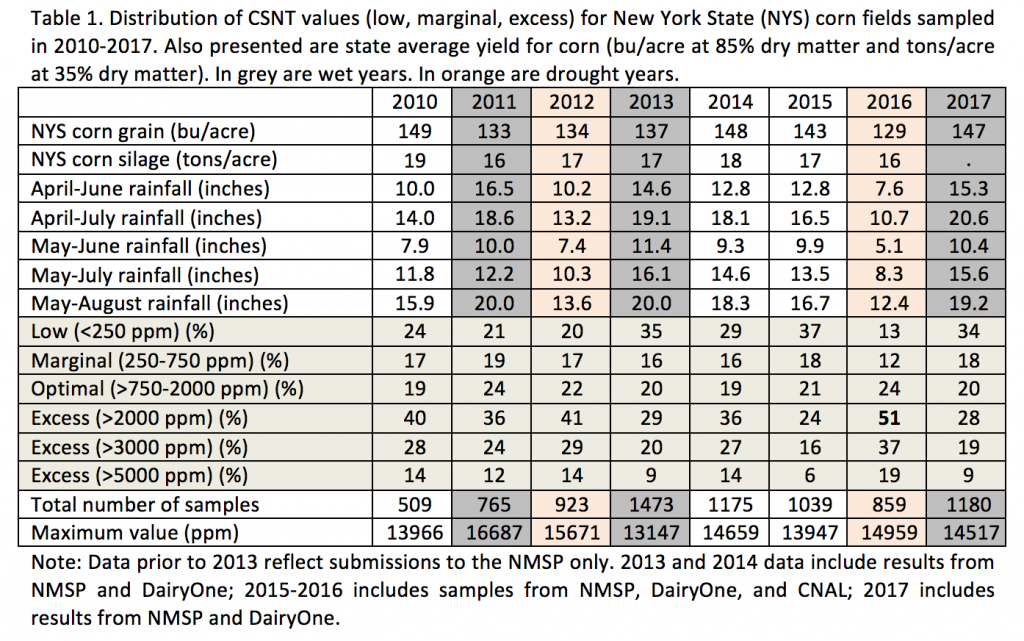Quirine Ketterings1, Karl Czymmek1,2, Sanjay Gami1, Mike Reuter3
Cornell University Nutrient Management Spear Program1, PRODAIRY2, and Dairy One3
Introduction
The corn stalk nitrate test (CSNT) allows for evaluation and fine-tuning of N management for individual fields over time. It is an end-of-season evaluation tool for N management for 2nd or higher year corn fields that allows for identification of situations where more N was available during the growing season than the crop needed. Where CSNT results exceed 3000 ppm for two or more years, it is highly likely that N management changes can be made without impacting yield.
Findings 2010-2017
The summary of CSNT results for the past eight years is shown in Table 1. For 2017, 28% of all tested fields had CSNTs greater than 2000 ppm, while 19% were over 3000 ppm and 9% exceeded 5000 ppm. In contrast, 34% of the 2017 samples tested low in CSNT. As crop history, manure history, other N inputs, soil type, and growing conditions all impact CSNT results, conclusions about future N management should take into account the events of the growing season. In addition, weed pressure, disease pressure, lack of moisture in the root zone in drought years, lack of oxygen in the root zone due to excessive rain (anaerobic soil conditions), and other stress factors can impact the N status of the crop as well. The 2017 data are consistent with 2013, another extremely wet year with 20 inches of rainfall between May and August. These data highlight the need to evaluate CSNT results in light of not only manure and fertilizer N management but also weather patterns that year. They also show the importance of multiple years of results to gain experience with on-farm interpretation.
Within-field spatial variability can be considerable in New York, requiring (1) high density sampling (equivalent of 1 stalk per acre at a minimum) for accurate assessment of whole fields, or (2) targeted sampling based on yield zones, elevations, or soil management units. Work is ongoing to evaluate targeted sampling that is expected to significantly reduce time commitment to taking CSNTs. Two years of CSNT data are recommended before making any management changes unless CSNT’s exceed 5000 ppm (in which case one year of data is sufficient).

Relevant References
- Instructions for CSNT Sampling; Cornell Nutrient Management Spear Program: http://nmsp.cals.cornell.edu/projects/nitrogenforcorn/StalkNtest.pdf.
- Agronomy Factsheets #31: Corn Stalk Nitrate Test (CSNT); #63: Fine-Tuning Nitrogen Management for Corn; and #72: Taking a Corn Stalk Nitrate Test Sample after Corn Silage Harvest. http://nmsp.cals.cornell.edu/guidelines/factsheets.html.
Acknowledgments
 We thank the many farmers and farm consultants that sampled their fields for CSNT. For questions about these results contact Quirine M. Ketterings at 607-255-3061 or qmk2@cornell.edu, and/or visit the Cornell Nutrient Management Spear Program website at: http://nmsp.cals.cornell.edu/.
We thank the many farmers and farm consultants that sampled their fields for CSNT. For questions about these results contact Quirine M. Ketterings at 607-255-3061 or qmk2@cornell.edu, and/or visit the Cornell Nutrient Management Spear Program website at: http://nmsp.cals.cornell.edu/.


